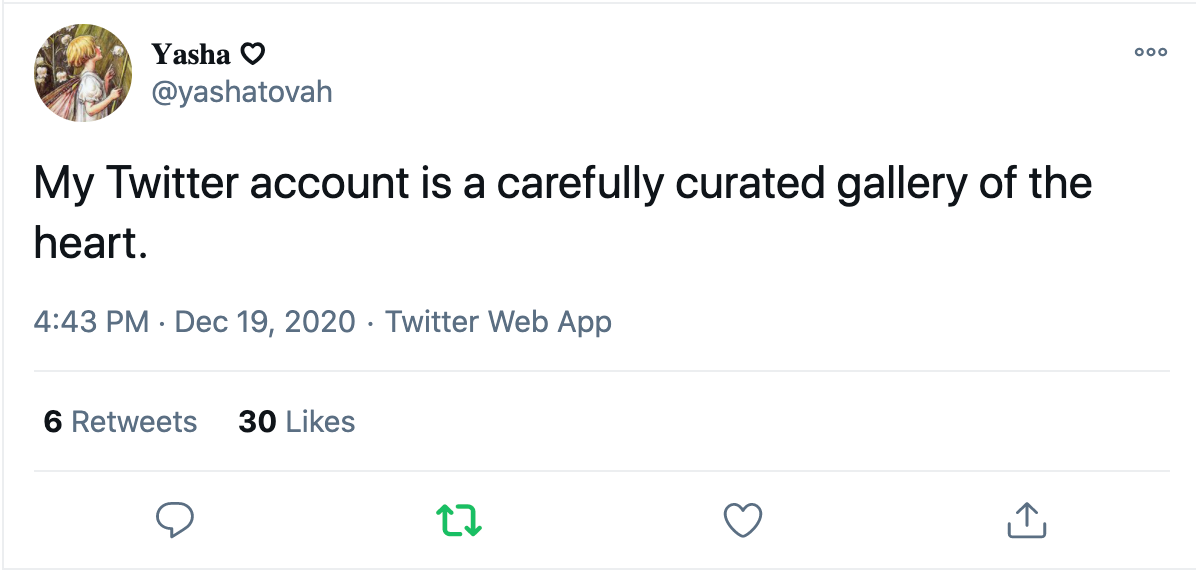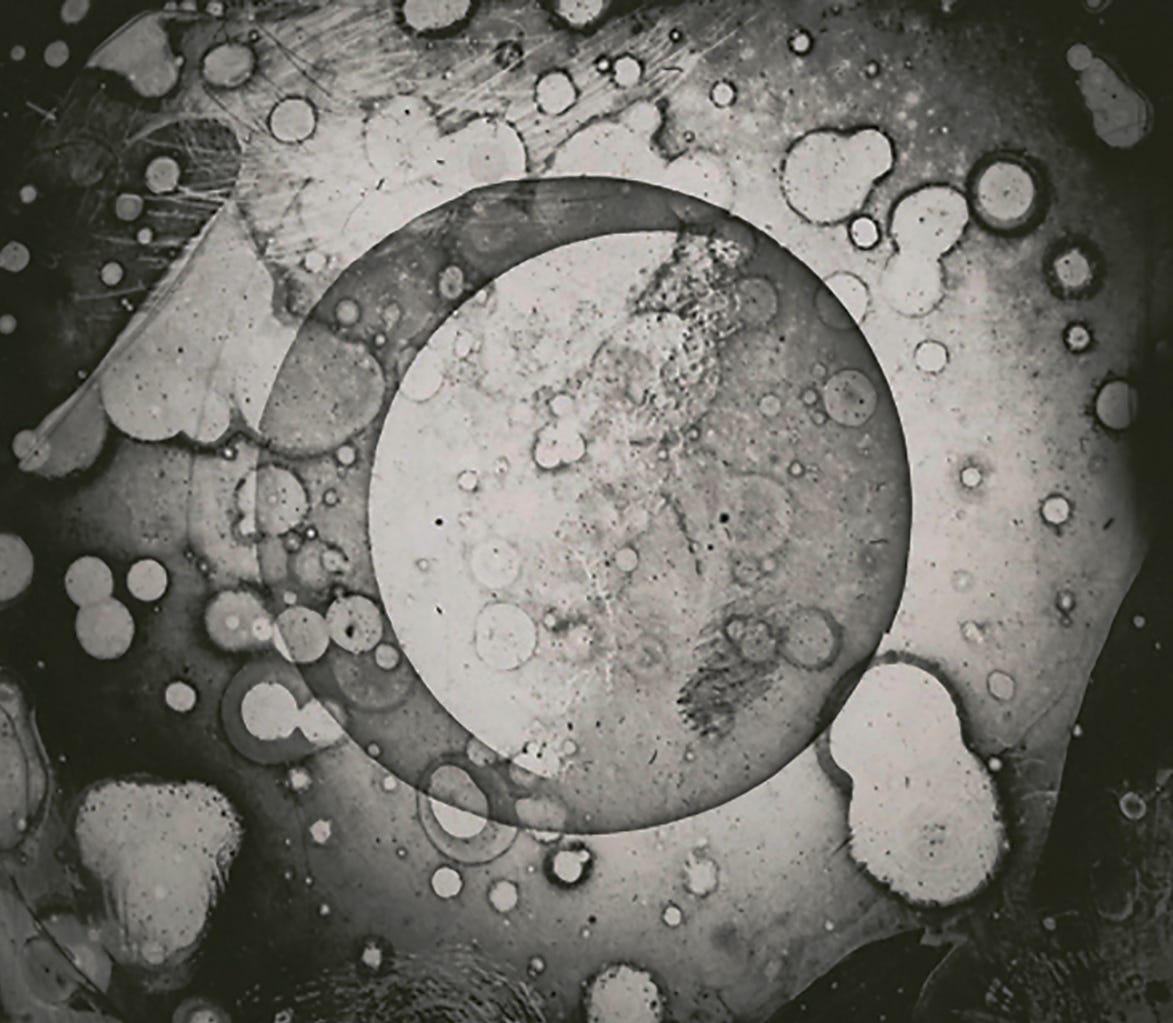Letter 32. Cabinet of Curiosities
Daguerreotypes, mackerel clouds, and notes from an afternoon run
Hi friends,
For the first time in Kopi Club history, we are both coming to you this week (still pajama-clad) from the same couch in Philly! What started off as a long distance project has come full circle. For those of you who have been following this inter-continental journey, thank you for sticking around.
A relevant tweet for a week full of curiosities – we hope that today’s letter also reflects this sentiment. (This week’s letter is a long one, so you can click on the green banner above to read the browser version!)
N:
Running, Perfectionism, and Choice
Doris Lessing: "what’s terrible is to pretend that the second-rate is first-rate. To pretend that you don’t need love when you do; or you like your work when you know quite well you’re capable of better.”
Having high standards is arguably good: to fundamentally believe in your value and your capability. However, perfectionism is a burden that renders you immobile when things are not ideal. The problem is teetering on the fine line between having high standards for oneself versus being a perfectionist, and using high standards as an excuse not to begin anything at all.
I thought about this while embarking on my first run in an absurdly long time. Sometimes running feels like floating but this was not one of those times. In the beginning, every stride felt blurred, unintentional, off-meter. The only thing that helped was focusing above instead of below, outward and upward. The clouds drew together and then pulled apart again, allowing the sunlight to stream through. Eventually, the brittle cold somehow seemed less real; everything became illuminated and buoyant instead of heavy. I just had to get over the hard part: starting. I understood then why some of my closest friends run marathons (hi, M and A): they love the feeling of moving through the temporary feelings. The act of growing closer and nearer to fluidity, to presence. A euphoria that is not unlike an untethering of mind and body.
Justine mentioned What I talk about when I talk about Running last week, but I quote Murakami here again:
“For me, running is both exercise and a metaphor. Running day after day, piling up the races, bit by bit I raise the bar, and by clearing each level I elevate myself… But that’s not the point. The point is whether or not I improved over yesterday. In long-distance running the only opponent you have to beat is yourself, the way you used to be.”
I don’t consider myself a runner, but when I tilt my head upward to the sky and pace forward, I am running all the same. Sometimes I feel like my perfectionism doesn’t allow me to consider myself a writer either, but the words that are on the page are writing all the same. If perfectionism is inertia, then I’ve decided I’d rather just start – and have faith that I will stumble into discovery as long as I am moving forward.
In the spirit of movement rather than perfection this week, I am sharing some personal writing. This is from my ‘morning pages’ (writing first thing when I wake up: a routine I’m currently in love with):
J:
An Ode to the Daguerreotype
Earlier this month, photography celebrated an important birthday – the presentation of the first daguerreotype to the French Académie des Sciences on January 7th, 1839.
Though the first known photograph was credited to Nicéphore Nièpce over a decade earlier (the picture below, which depicts the view from a window in his hometown, was made using bitumen exposed to light over the course of several days; an evident difference from the photography we think of today), it was Louis Daguerre’s process that ushered photography onto its path towards commercial success.
To create these daguerreotypes, silver-plated copper sheets are exposed to light; from there, the sheets are exposed to mercury fumes before the resulting imprint is fixed with a common salt solution. Unlike Nièpce’s work, the resulting images are much clearer in resolution.
For this reason, some of the earliest applications of Daguerre’s process were not constrained to the world of art, but used for scientific exploration as well. What was knowable to man was no longer determined by the limits of human vision; instead, daguerreotypes opened up study to the realm of both the macro and microscopic. Early daguerreotypes were taken to study the anatomy of insects, as well as to record the surface of the moon; before this, scientists had to rely on hand-drawn sketches. Though I take pictures of the moon without second thought, the ability to create lunar portraits in the 1840s was a milestone; below are some of the images taken by the world’s first group of astrophotographers.
The daguerrotype’s story seems laden with these connections between art and science: that Daguerre was both inventor and artist; that beautiful images are born out of chemical reactions. Though I initially grew up seeing these two fields as fundamentally different – opposites, even – learning more about the history of photography is proof that they’ve always been intertwined.
N:
‘Dancing in My Room’ Songs
And an OLD favorite song ‘You Belong to Me’ from the movie The Jerk. I’ve been singing it over and over. The trumpet + ukulele combination is perfect.
J:
A playlist…
For the many long nights indoors in the foreseeable future. Both Nicole and I have been trying to fight off our jetlag, and this playlist has already accompanied many drowsy evenings spent unpacking and attempting to stay awake past 8.
And a podcast…
This episode of The On Being Project goes along with the quote I’ll be sharing this week! Currently reading Katherine May’s Wintering – an exploration of both our physical and psychological “winters”, and how these periods of respite shape us.
The book deals with some heavier emotions – unhappiness, loneliness – but I’m moved by the way May makes a case for their necessity. An excerpt from the episode:
Reminds me of another beautiful quote, from Ursula Le Guin: “If you evade suffering you also evade chances of joy….The thing about working with time, instead of against it ...is that it is not wasted. Even the pain counts”.
N:
Some Interesting Facts
Bumble’s IPO: While there are thousands of publicly traded companies, only 20 women have taken their startups public (a surprisingly small number. Hope to see this increase in the next few years with more female CEOs!)
From the book Vesper Flights:
“They used to think that we record a short-term memory, then archive it later, move it to a different part of the brain to store it to long-term. But now they’ve discovered that the brain always records two tracks at once. That it is always taping two stories in parallel. Short-term memories, long-term memories, two tracks of running recollection, memory doubled. Always doubled.”
Elle Sanders writes this:
“It can take a person years to find the right places in which to properly store and comprehend an event that takes only seconds.”
I’ve always thought that memory is unreliable – things are more mystic, more romantic, more painful, more dull when we remember them, not as they really are.
This is too large to be true, but I found it hilarious – imagine if people just quit working out and started playing chess.
J:
People…
This is not the first time that I’ve talked about my Youtube girl-crush Anna Edit in this newsletter, and it most likely won’t be the last. She recently moved with her husband to a new house in Brighton; her moving vlogs also make me want to move to the English countryside.
Places…
The Gardens at Awaji Yumebutai
The Awaji Yumebutai complex in Japan’s Hyogo prefecture was initially designed to house a park built on the side of a mountain; however, when the island suffered a devastating earthquake, the site was resigned to serve as a memorial for the lives lost.
The 100 Step Garden is now a symbol of peace, meant to calm the souls of those who passed away in the 1995 earthquakes. The site is indeed beautiful – a grid of 100 square-shaped flower beds tucked away in the mountainside. They remind me of the rice terraces from my own home country of the Philippines. Each week, it seems that the post-COVID travel bucket list continues to grow 😌
… & Things
Mackerel Skies
Although the last time I properly took the time to learn cloud lingo was in the first grade, I finally learned the term used to describe the way the sky looks when the clouds seem to bunch up and form long bands; it always makes me think of bunched up bedsheets.
The reason mackerel skies assume a wave-like pattern is because they are exactly that - disturbances in air pressure or temperature can cause atmospheric waves (however, I do also love the term the French use – ciel moutonné, or fleecy sky).
N:
“Man will never be the master of time but how curious it would be to be able at least to stop it to examine at leisure the nuance that escapes us, the ray that’s out of place, that shade whose ungraspable velvet isn’t made for our touch.” – Vladimir Nabokov (Quote Credit: Brave New Decade)
J:
From the current bedside read:
"We are in the habit of imagining our lives to be linear, a long march from birth to death in which we mass our powers, only to surrender them again, all the while slowly losing our youthful beauty. This is a brutal untruth. Life meanders like a path through the woods. We have seasons when we flourish and seasons when the leaves fall from us, revealing our bare bones. Given time, they grow again.” – Katherine May, Wintering
N:
Nicole’s Inventory of the Week
A Question I Want to Answer:
“Balancing practicality with the heart is tough. How do you learn to be materially secure while also believing in magic?” (@_moimichelle)
A Note to Self:
When you experience something new, your first instinct is to fall back on mental models that worked in the past: warm, traditional, familiar. But clinging onto familiarity only dampens the joy of novelty – new things and newer things can be beautiful and timely, if you let them be.
This Week I am Reading:
Piranesi by Susanna Clark
Everything in its Place by Oliver Sacks
This Week I am Loving:
Art by @chrisaustinart
J:
Paintings for when you’re missing summertime
Following the Tate instagram account has been a great way for me to learn about new artists and their work. Recently, they featured a series of still life paintings by Mary Fedden. Interestingly, though Fedden’s work is often likened to that of Picasso, I learned that she herself was actually a teacher; she even taught painting to the likes of Hockney and Caulfield. This always makes me think of the many other lesser-known (and even hidden) women of the art world.
These were some of my favorite pieces – they make me miss the summer heat, stone fruit, and the season of picnics.
PS: Thank you all for the lovely comments regarding last week’s newsletter + the changes we made to KC’s design! We’re humbled by how much this community still continues to grow and inspire us, so thank you all for the kind messages.
Hugs,
J & N

























“Each week, it seems that the post-COVID travel bucket list continues to grow”
Amen to that 😅😭
I love these newsletters, perfect way to settle into a Sunday morning with a cup of kopi !